helicopters

helicopter pod

helicopter gun pod
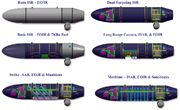
multi Mission pods

pylon Sensor Pod

rocket pods

rocket launcher pods European
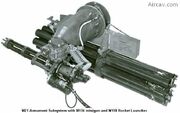
m21m158
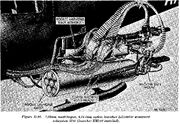
M16 gun

rocket launcher
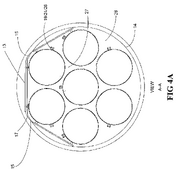
Front rocket pods launcher

chopper gun pod

XM157_Rocket_Pod
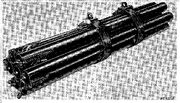
XM158_Rocket_Pod

APKWS
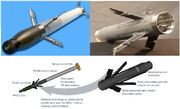
APKWS European rocket launcher

rocket system

ORD_APKWS_Diagram_Labeled
Raytheon Systems .Company (which was previously Hughes Missile Systems Company) BGM-71 A Basic Tube-launched Optically tracked Wire-guided (TOW) Anti-Tank Guided Weapon (ATGW) entered operational service with the US Army in 1970 for use from ground, vehicle and helicopter mounts.
It is fitted with Command to Line Of Sight guidance (CLOS) and all the gunner has to do is to keep the cross-hairs of his sight on the target until the missile impacts.
In 1976, production was switched from the BGM-71A round to the BGM-71 B extended-range basic TOW variant and then again in 1981 to the BGM-71C Improved TOW which has an enhanced copper lined warhead capable of defeating the Soviet armour technology that was being fielded at the time.
This involved the fitting of a 127 mm calibre warhead with a 26b mm long telescopic nose probe fuze system that pops out when the missile is in flight to provide the optimum standoff penetration capability to the missile's shaped charge. The second phase of the warhead improvement programme, the BGM-71 D TOW-2 missile, was introduced in 1983 with a heavier 152 mm calibre copper lined warhead, a 345 mm long telescopic nose probe, improved and countermeasures hardened digital guidance and a new propulsion system.
However, in order to defeat tanks fitted with Explosive Reactive Armour (ERA) blocks, the US Army started an upgrade programme in December 1984 and fielded the BGM-71 E TOW-2A variant in 1987. This has an improved direct attack warhead which incorporates a small shaped charge into the extendable nose probe of the TOW-2 to cause a premature explosion in any ERA block it hits so that the main copper lined warhead charge remains effective in penetrating the conventional

Creator of a Billion Light Years Away Ombudsman
armour plate behind. Additional ballast was added to the aft end of the missile to accommodate the extra weight of the new probe; a redesigned safe-and-arm device and an electronic timing device to provide the necessary delay between the tip and main charges were also added. Following initial development work started in 1987, it was announced in April

bell Huey Helicopter diagram
1988 that the now Raytheon Systems Company had been awarded a contract for full-scale development of the BGM-71 F TOW-2B ATGW. The contract, valued at US$35 million, was awarded to the now Raytheon Systems Company by the then US Army Missile Command. The missile entered service in 1991.
The TOW-2B (formerly the TOW lethality improvement programme) is a product improved variant with an Overflight Top Attack (OTA) capability. It is fitted with two downward sequentially fired Aerojet Electro Systems tantalum Explosive Formed Projectile (EFP) warheads and the Thomson-Thorn Missile Electronics dual-mode active optical laser profilometer and magnetic sensor fuzing device (see FITOW variant later) in a redesigned forebody ahead of the rocket motor unit.
The warheads are aligned in parallel so that they provide independent shot lines. An advanced guidance programme has been developed which is automatically initiated as the TOW-2B round leaves the launch tube. The gunner still places his cross-hairs on the target but the missile is now commanded to fly at a set height above the line of sight so that OTA can occur.
Under contract to Missile Command, the now Raytheon Systems Company has completed development of a wireless command link for the TOW ATGW. Successful firing trials of this version, known as TOW-2N, were carried out at Redstone Arsenal in Huntsville, Alabama, in mid-1988. Instead of using fine steel wires that pay out from two bobbins in the back of a conventional TOW missile, guidance commands were sent from the launch station to the missile via a secure millimetre-wave datalink.
The test programme used TOW-2 missiles modified to include the millimetre-wave receiver, antenna and processor in place of the wires and bobbins. The TOW-2 launcher was modified with a millimetre-wave transmitter and antenna and an additional electronics card. The weight of the wireless hardware in the missile was less than that of the wires and bobbins. A production version would incorporate a larger rocket motor and would have a typical engagement range of 5,000 m. As of mid-1999, there were no plans for this version of TOW to enter production.
Under contract to the British Ministry of Defence Thomson-Thorn Missile Electronics has developed the UK Further-Improved TOW (FITOW) which uses a Thomson-Thorn Missile Electronics fuze and Royal Ordnance top attack warheads. This was developed for the Lynx helicopters of the Army Air Corps and has been retrofitted to existing missiles.
The FITOW variant uses a Thomson-Thorn Missile Electronics forebody with a dual-mode fuzing device. This comprises an active optical laser altimeter that measures the profile of the terrain being overflown and fires two near-vertically aligned shaped charge warheads into the top of the target when it detects the profile of a tank and the onboard magnetometer sensor confirms the presence of a large metallic mass (so as to prevent unwanted firings against decoys and so on). The target vehicle can be approached by the missile from any direction. Raytheon Systems Company has also modified the missile guidance loop so that FITOW flies above the gunner's line of sight in order to permit the OTA flight profile.

helicopter gunship diagram

helicopter gunship diagram
For fitting to 127 mm calibre warhead TOW variants, Israel Military Industries
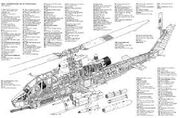
Huey Cobra diagram
has developed a replacement tandem warhead unit that is specifically designed to defeat ERA-equipped tanks. A spring-loaded retractable probe is fitted which extends upon launch. It has a precursor PBX HE charge at its tip which is triggered at the optimum standoff distance by an active laser proximity fuze. This 'neutralises' the overlying protective ERA layer and allows the main protected warhead charge, comprising a precision shaped PBX HE charge and copper liner, to explode and penetrate the tank's actual armour plate located beneath.
TOW has seen extensive combat use in a number of conflicts including Angola, Chad, the 1973 Yom Kippur War, Lebanon, the Iran-Iraq War, the Thai-Cambodian border skirmishes, the Thai-Laotian border skirmishes, the Vietnam War and the 1990-91 Gulf War.
In the latter conflict, a number of countries used the TOW system. The US Army/US Marine Corps alone shipped some 50,000 rounds into the theatre of operations, of which over 3,000 (primarily TOW-2 and TOW-2A) were fired at a wide variety of targets varying from T-72 MBTs to machine gun emplacements and individual snipers.
In the Battle of Khafji, counterattacking Saudi Arabian TOW gunners alone destroyed 46 armoured vehicles, whilst assisting US Marine Corps Cobra helicopters helped destroy a further 20 tanks and APCs.
Late in 1996, the now Raytheon Systems Company stated that there were over 15,000 TOW launchers (including helicopters) deployed in the world with current production models being the TOW-2A and TOW-2B. Total production has now passed 600,000 missiles and is scheduled to continue through the remainder of this century.
The TOW BLAAM (Bunkers Light Armour and Masonry) warhead has been developed to the prototype stage by Raytheon Systems Company and Aerojet and has been optimised to defeat targets behind concrete and masonary walls, and in bunkers, at extended ranges using existing TOW launchers. The warhead is retrofittable to existing TOW missiles with no changes required to the guidance system.
The US Army holds stock of TOW Improved TOW and TOW 2 for contingency and training only. TOW-2A and TOW-2B are now the only operational tactical rounds.
The Follow-On To TOW (FOTT) programme has been cancelled (Jane's Armour and Artillery Upgrades 1998-99 pages 81 to 82). As an interim solution a TOW Technology Insertion programme is now being studied which will be of the fire-and-forget type.
Status
BGM-71A/B production complete. In service with Bahrain, Canada, Chad, Colombia, Denmark, Ethiopia, Germany, Greece, Iran, Iraq, Israel,.Italy, Jordan, Kenya, South Korea, Kuwait, Lebanon, Luxembourg, Morocco, Netherlands, Norway,. Oman, Saudi Arabia, Somalia, Spain, Taiwan, Thailand, Tunisia, UNITA movement, the UK, the USA and Yemen.
BGM-71C production essentially complete. In service with Botswana, Egypt, Finland (as M83), Greece, Israel, Italy, Japan, South Korea, Kuwait, Netherlands, Pakistan, Saudi Arabia, Spain, Sweden (as Rb55), Thailand, Turkey, the UK and the USA.
BGM-71D in production. In service with Bahrain, Belgium, Canada, Denmark, Egypt, Finland, Germany, Italy, Netherlands, Norway, Pakistan, Portugal, Saudi Arabia, Singapore, Spain, Sweden, Switzerland (licence-built), Thailand, Turkey and the USA.
BGM-71E in production. In service with the USA, Canada, Italy and several other countries.
BGM-71F in production. In service with Italy and the USA.
Armoured vehicle applications
Tracked Desert Warrior (two single-tube turret launchers - Kuwaiti Army)
Tracked M2/M2A1/M2A2 (twin-tube turret launcher - 3,682 delivered to US Army, 400 to Saudi Arabia) Being upgraded with improved Bradley Acquisition system (IBAS).
Tracked M3/M3A1 (twin-tube turret launcher - US Army)
Tracked M113 series (single-tube launcher - Danish, Egyptian, Greek, Israeli, Italian, Portuguese, Somali, Thai, Tunisian, Turkish and US armies)
Tracked M901 (twin-tube ITVturret launcher- Egyptian, Greek, Jordanian, Kuwaiti and Pakistani armies)
Tracked VCC-1 (twin-tube ITV turret launcher - Saudi Arabian Army)
Tracked Jaguar 2 (single-tube launcher- German Army)
Tracked YPR-765 PRAT (twin-tube ITV turret launcher-Royal Netherlands and Egyptian armies)
Tracked NM142 (twin-tube Kvaerner-Eureka turret launcher - Norwegian Army, this version is also in service with Canadian Forces on the M113A1 APC and with the
Turkish Army on modified Armored Infantry Fighting Vehicle chassis)
Tracked Pvrbv551 (single-tube launcher-Swedish Army)
Tracked AIFV (single-tube launcher - Taiwanese Army)
Tracked M42 Mod (single-tube launcher - Taiwanese Army)
Tracked Wiesel Airportable Vehicle (single-tube launcher- German airborne troops)
8x8 LAV(AT) (twin-tube ITV turret launcher - Saudi Arabian National Guard and US Marine Corps)
6x6 MOWAG Piranha (twin-tube Kvaerner-Eureka turret launcher - Swiss Army)
4x4 RBY Mk-1 (single-tube launcher - Israeli Army)
4x4 LAV-150 (single-tube launcher - Saudi Arabian
National Guard and Taiwanese Army) 6 x 6 M8 Mod (single-tube launcher - Colombian Army).
Tracked Dardo Hitfist (on order for Italian Army) (one TOW launcher either side of turret)
Tracked BWP 2000 (one TOW launcher either side of turret -tested by Polish Army).
The BGM-71 TOW wire-guided heavy anti-tank missile is produced by Raytheon Systems Company. The weapon is used in anti-armour, anti-bunker, anti-fortification and anti-amphibious landing roles. TOW is in service with over 40 armed forces and is integrated on over 15,000 ground, vehicle and helicopter platforms worldwide.
TOW 2 missile system development[]
The TOW missile system has been in service since 1970 with more than 650,000 missiles produced. Current production versions are: TOW 2A (BGM-71E), which entered production in 1987 with over 118,000 missiles delivered; TOW 2B (BGM-71F), which entered production in 1991 with over 40,000 missiles delivered and is designed to complement rather than replace TOW 2A; TOW 2B Aero; and TOW 2A bunker buster (BGM-71H).
A production contract for the new extended-range TOW 2B Aero was awarded by the US Army in February 2004. The contract was for 976 missiles, delivered by December 2006. A US Army contract for more than 2,700 TOW 2B and TOW 2B Aero missiles (including practice rounds) was placed in July 2004. TOW 2B Aero with ITAS has been selected for the US Marine Corps' next-generation AAWS-H (anti-armour weapon system-heavy) programme.
The TOW 2 missile system was deployed in support of Operation Iraqi Freedom, which constituted the first operational firing of the TOW 2B missile.
TOW 2 missile orders and deliveries[]
"TOW 2 is used in anti-armour, anti-bunker, anti-fortification and anti-amphibious landing roles."In August 2005, Kuwait requested the sale of 436 (292 TOW 2A, 144 TOW 2B) TOW missiles.
In September 2006, the US Army placed the first production contract, with five one-year options, for the new TOW 2B RF missile, a wireless version.
In October 2007, the US Congress was notified of the proposed sale of 2000 TOW 2A missiles to Pakistan and 2000 TOW 2A missiles to Israel.
In November 2007, Canada placed an order for 462 TOW 2A RF bunker buster missiles, the first export order for this missile variant.
In January 2008, Kuwait requested the sale of 2,106 TOW 2A RF and 1,404 TOW 2B RF missiles.
In September 2008, Egypt requested the sale of 6,900 TOW 2A missiles to replace its ageing inventory.
In July 2010, the US government placed a $55m contract with Raytheon to deliver TOW missiles to Saudi Arabia under a foreign military sales agreement.
Raytheon Technical Services received a $77.9m contract in March 2012 to deliver logistics and engineering support for subsystems and related equipment of the US Army TOW missiles.
In October 2012, Raytheon was awarded a $349m five-year contract to deliver 6,676 new wireless TOW missiles to the US military.
TOW 2 vehicle and air-mounted missile systems[]
The missiles can be fired from the ground using a tripod-mounted launch tube or installed on vehicles. The TOW missile system can be fitted as a single-tube pedestal mount on military vehicles or as two-tube or four-tube under-armour systems on vehicles such as the improved TOW vehicle M901, Desert Warrior, Piranha, US Marine Corps LAV, Dardo Hitfist and Bradley M2/M3.
Airborne TOW is in service in more than 13 countries. Over 2,100 units have been delivered and helicopters fitted with the TOW missile include the AgustaWestland Lynx, AgustaWestland A129, Bell Textron 206L, UH-1 Huey, Hughes 500MD helicopter, Eurocopter Bo 105 and Bell Textron AH-1 Cobra attack helicopter

Minigun
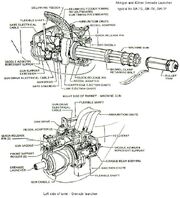
M28 Minigun

Minigun

XM-97 Turret
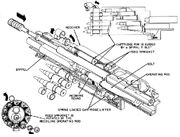
Diagram_of_the_ShKAS_feed_system_operation

apm2.6discoprowithminimosd
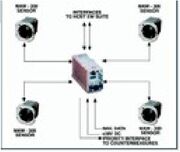
Electronic chopper

helicopter electronics

Multirotor basic wiring hookup

Radar-and-EW-challenges

helicopter instrument electronics

CH-60 diagram

APM connection
http://www.cbc.ca/news/technology

AAR Principles
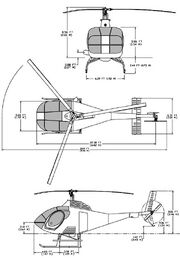
Chopper diagram
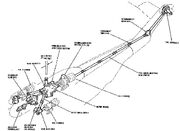
engine assembly helicopter
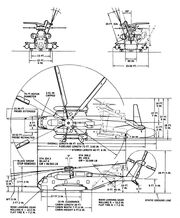
Parts of Sikorsky
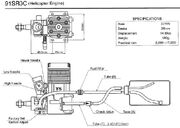
helicopter engine

Helicopter tube launchers

TOW missile launcher AH-1

helicopter TOW launcher
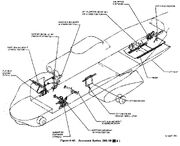
H3E diagram

chopper diagram
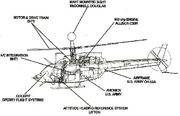
Kiowa diagram

Merlin Airframe
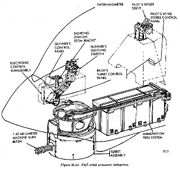
TAT-102A schematic
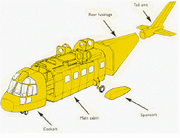
parts helicopter
A military helicopter is a helicopter that is either specifically built or converted for use by military forces. A military helicopter's mission is a function of its design or conversion. The most common use of military helicopters is transport of troops, but transport helicopters can be modified or converted to perform other missions such as combat search and rescue (CSAR), medical evacuation (MEDEVAC), airborne command post, or even armed with weapons for attacking ground targets. Specialized military helicopters are intended to conduct specific missions. Examples of specialized military helicopters are attack helicopters, observation helicopters and anti-submarine warfare helicopters.
Contents[]
- 1 Types and roles
- 2 Tactics and operations
- 3 Manufacturers
- 4 See also
- 5 Notes
- 6 References
- 7 External links
Types and roles[]
Military helicopters play an integral part in the sea, land and air operations of modern militaries. Generally manufacturers will develop airframes in different weight/size classes which can be adapted to different roles through the installation of mission specific equipment. To minimise development costs the basic airframes can be stretched and shortened, be updated with new engines and electronics and have the entire mechanical and flight systems mated to new fuselages to create new aircraft. For example, the UH-1 has given rise to a number of derivatives through stretching and re-engining, including the AH-1.
Modern helicopters have introduced modular systems which allow the same airframe to be configured for different roles, for example the EH-101 in Royal Navy service can be rapidly configured for ASW or transport missions in hours. To at the same time retain flexibility and limit costs, it is possible to fit an airframe for but not with a system, for example in the US Army's AH-64D variants are all fitted to be able to take the Longbow radar system, but not enough sets have been bought to equip the whole force. The systems can be fitted to only those airframes that need it, or when finances allow the purchase of enough units.
Equipment[]
Most military helicopters are armoured to some extent however all equipment is limited to the installed power and lift capability and the limits installed equipment places on useful payload. The most extensive armour is placed around the pilots, engines, transmission and fuel tanks. Fuel lines, control cables and power to the tail rotor may also be shrouded by Kevlar armour. The most heavily armoured helicopters are attack, assault and special forces helicopters. In transport helicopters the crew compartment may or may not be fully armoured, a compromise being to give the passengers Kevlar lined seats but to leave the compartment for the most part unarmoured. Survivability is enhanced by redundancy and the placement of components to protect each other. For example, the Blackhawk family of helicopters uses two engines and can continue to fly on only one (under certain conditions), the engines are separated by the transmission and placed so that if attacked from any one flank, the engine on that flank acts to protect the transmission and the engine on the other side from damage.
Aviation electronics, or avionics, such as communication radios and navigation aids are common on most military helicopters. Specialized avionics, such as electronic countermeasures and identification friend or foe systems, are military specific systems that can also be installed on military helicopters. Other payload or mission systems are installed either permanently or temporarily, based on specific mission requirements; optical and IR cameras for scout helicopters, dunking sonar and search radar for anti-submarine helicopters, extra radio transceivers and computers for helicopters used as airborne command posts.
Armour, fire suppression, dynamic and electronics systems enhancements are invisible to casual inspection, as a cost-cutting measure some nations and services have been tempted to use what are essentially commercial helicopters for military purposes. For example, it has been reported that the PRC is carrying out a rapid enlargement of its assault helicopter regiments with the civilian version of the Mil Mi-17.[1] These helicopters without armour and electronic counter measures will function well enough for training exercises and photo opportunities but would be suicidal to deploy in the assault role in actual combat situations. The intention of China appears to be to retrofit these helicopters with locally produced electronics and armour when possible, freeing available funds to allow rapid creation of enough regiments to equip each of its Group Armies, allowing a widespread buildup of experience in helicopter operations.
Attack helicopters[]
Main article: Attack helicopterAttack helicopters are helicopters used in the anti-tank and close air support roles. The first of the modern attack helicopters was the Vietnam era AH-1 Cobra, which pioneered the now classic format of pilot and weapons officer seated in tandem in a narrow fuselage, chin mounted guns, and rockets and missiles mounted on stub wings. To enable them to find and identify their targets, some modern attack helicopters are equipped with very capable sensors[2] such as a millimeter wave radar system.
- Attack helicopters
- [1]A Russian Mi-24P Hind-F large helicopter gunship and low-capacity troop transport.
- [2]Westland WAH-64 Apache Longbow attack helicopter operated by the British Army.
- [3]Cobra attack helicopters being refueled at a FARP during Operation Iraqi Freedom
- [4]A Mi-28
- [5]A Ka-52 in flight
Transport helicopters[]
Main article: Transport helicopterTransport helicopters are used for transporting personnel (troops) and cargo in support of military operations. In larger militaries, these helicopters are often purpose-built for military operations, but commercially available aircraft are also used. The benefit of using helicopters for these operations is that personnel and cargo can be moved to and from locations without requiring a runway for takeoffs and landings. Cargo is carried either internally, or externally by slung load where the load is suspended from an attachment point underneath the aircraft. Personnel are primarily loaded and unloaded while the helicopter is on the ground. However, when the terrain restricts even helicopters from landing, personnel may also be picked up and dropped off using specialized devices, such as rescue hoists or special rope lines, while the aircraft hovers overhead.
Air assault is a military strategy that relies heavily on the use of transport helicopters. An air assault involves a customized assault force that is assembled on the pick-up zone and staged for sequential transport to a landing zone (LZ). The idea is to use the helicopters to transport and land a large number of troops and equipment in a relatively short amount of time, in order to assault and overwhelm an objective near the LZ. The advantage of air assault over an airborne assault is the ability of the helicopters to continually resupply the force during the operation, as well as to transport the personnel and equipment to their previous location, or a follow-on location if the mission dictates.
- Transport helicopters
- [6]Mil Mi-17 transport of the Kazakhstan government.[note 1]
- [7]A Wiesel deploys from a CH-53
- [8]CH-21C with 105mm howitzer as a slung load
- [9]UH-1D helicopters airlift members of a U.S. infantry regiment, 1966
- [10]A Mi-26 of the Russian Ministry for Emergency Situations
Observation helicopters[]
The first reconnaissance and observation aircraft were balloons, followed by light airplanes, such as the Taylorcraft L-2 and Fieseler Fi 156. As the first military helicopters became available, their ability to both maneuver and to remain in one location made them ideal for reconnaissance. Initially observation helicopters were limited to visual observation by the aircrew, and most helicopters featured rounded, well-glazed cockpits for maximum visibility. Over time, the human eye became supplemented by optical sensor systems. Today, these include low light level television and forward looking infrared cameras. Often, these are mounted in a stabilised mount along with multi-function lasers capable of acting as laser rangefinder and targeting designators for weapons systems.[3]
By nature of the mission, the observation helicopter's primary weapons are its sensor suite and communications equipment. Early observation helicopters were effective at calling for artillery fire and airstrikes. With modern sensor suites, they are also able to provide terminal guidance to ATGWs, laser-guided bombs and other missiles and munitions fired by other armed aircraft.[4][5] Observation helicopters may also be armed with combinations of gun and rocket pods and sometimes anti-tank guided missiles or air-to-air missiles, but in smaller quantities than larger attack helicopters.[6] Primarily, these weapons were intended for the counter-reconnaissance fight—to eliminate an enemy's reconnaissance assets—but they can also be used to provide limited direct fire support or close air support.
- Observation helicopters
- [11]A Gazelle helicopter of the French ALAT.
- [12]An OH-58 Kiowa showing its mast mounted sight and a rocket pod.
- [13]The Kawasaki OH-1.
Maritime helicopters[]
See also: Maritime patrol aircraftAmong the first practical uses of helicopters when the R-4 and R-5 became available to US and UK forces was deployment from navy cruisers and battleships, at first supplementing and later replacing catapult-launched observation aircraft. Another niche within the capability of the early helicopters was as plane guard - tasked with the recovery of pilots who had ditched near an aircraft carrier.
As helicopter technology matured with increased payload and endurance, anti-submarine warfare (ASW) was added to the helicopter's repertoire. Initially, helicopters operated as weapons delivery systems, attacking with air-launched torpedoes and depth charges based on information provided by its parent and other warships. In the 1960s, the development of the turboshaft engine and transistor technology changed the face of maritime helicopter aviation. The turboshaft engine allowed smaller helicopters, such as the Westland Wasp, to operate from smaller vessels than their reciprocating engine predecessors. The introduction of transistors allowed helicopters, such as the SH-3 Sea King, to be equipped with integral dunking sonar, radar and magnetic anomaly detection equipment. The result was an aircraft able to more quickly respond to submarine threats to the fleet without waiting for directions from fleet vessels.
Today, maritime helicopters such as the SH-60 Seahawk and the Westland Lynx are designed to be operated from frigates, destroyers and similar size vessels. The desire to carry and operate two helicopters from frigate- and destroyer-sized vessels has affected the maximum size of the helicopters and the minimum size of the ships. Increasing miniaturisation of electronics, better engines and modern weapons now allow even the modern, destroyer-based, multi-role helicopter to operate nearly autonomously in the ASW, anti-shipping, transport, SAR and reconnaissance roles.
Medium- and large-sized helicopters are operated from carriers and land bases. In the British, Spanish, and Italian navies, the larger helicopters form the main anti-submarine strength of carrier air wings. When operating from shore bases, the helicopters are used as anti-submarine pickets to protect against hostile submarines loitering outside military ports and harbours; their endurance and payload providing advantages over smaller helicopters.
Soviet maritime helicopters, operating from its cruisers, had the additional role of guidance of the cruisers' long range anti-shipping missiles.
Maritime helicopters are navalised aircraft for operation from ships, this includes enhanced protection against salt water corrosion, protection against ingestion of water and provision for forced ditching at sea.
- Maritime helicopters
- [14]A Royal Navy Merlin HM1 anti-submarine warfare helicopter in 2007
- [15]A SH-60B Seahawk 2 helicopter
- [16]A Kamov Ka-27 shipborne helicopter, showing its contra-rotating rotor system, and bulbous radar radome
- [17]A Harbin Z-9
- [18]A NH-90
Multi-mission and rescue[]
As helicopters came into military service, they were quickly pressed into service for search and rescue[note 2] and medical evacuation. During World War II, Flettner Fl 282s were used in Germany for reconnaissance, and Sikorsky R-4s were used by the United States to rescue downed aircrews and injured personnel in remote areas of the China Burma India Theater, from April 1944 until the war's end. The use of helicopters for rescue during combat increased during the Korean War and the Algerian War. In the Vietnam War the USAF acquired Sikorsky S-61R (Jolly Green Giant) and CH-53 Sea Stallion (Super Jolly Green Giant) helicopters for the CSAR mission.[7]
- Multimission and Rescue helicopters
- [19]Bell 47 with patient transfer panniers.
- [20]Fast-roping at a Combat Search and Rescue action, featuring a HH-60G Pave Hawk.
- [21]Patient transfer unit for the German Army Aviation Corps CH-53Gs.
Training helicopters[]
Some services use a version of their operational helicopters, usually in the light class, for pilot training. For example, the British have used the Aérospatiale Gazelle both in operations and as a trainer. Some services also have an Ab initio phase in training that uses very basic helicopters. The Mexican Navy has acquired a number of the commercially available Robinson R22[8] and R44 helicopters for this purpose.
Utility Helicopter[]
Main article: Utility helicopterA utility helicopter is a multi-purpose helicopter. A utility military helicopter can fill roles such as ground attack, air assault, military logistics, medical evacuation, command and control, and troop transport.[9]
Tactics and operations[]
[22] First generation Alouette anti-tank helicopter of the German Army armed with SS.10 missiles[23] An OH-58 and an AH-1 of the Hawaii ARNG, such a combination would have formed hunter-killer team during the Cold War.[7]While not essential to combat operations, helicopters give a substantial advantage to their operators by being a force multiplier. To maximise their impact, helicopters are utilised in a combined arms approach.[10]
High intensity warfare[]
High-intensity warfare is characterized by large arrays of conventional armed forces, including mass formations of tanks, with significant air defenses. Helicopter armament and tactics were changed to account for a less-permissive flight environment. Anti-tank missiles, such as the SS.11 and the Aérospatiale SS.12/AS.12 were developed and mounted on French military helicopters. In turn, the United States adapted its BGM-71 TOW for firing from helicopters and eventually developed the AGM-114 Hellfire. Meanwhile, the Soviet Union adapted the 3M11 Falanga missile for firing from the Mil Mi-24.
In the air, attack helicopters armed with anti-tank missiles, and one or more unarmed, or lightly armed scout helicopters operate in concert. The scout helicopter, flying at low level in a nap-of-the-earth approach, attempts to both locate the enemy armoured columns and to map out approaches and ambush positions for the attack helicopters. Late-model scout helicopters include laser designators to guide missiles fired from the attack helicopters. After finding a target, the scout helicopter can locate it and then direct the attack helicopter's missile where to fire. The attack helicopters have only to rise from cover briefly to fire their missiles before returning to a concealed location.[7] Late-development of attack helicopters, such as the Mil Mi-28N, the Kamov Ka-52, and the AH-64D Longbow, incorporate sensors and command and control systems to relieve the requirement for scout helicopters.
To enhance the combat endurance of these missile-armed helicopters, transport helicopters were used to carry technicians, reloads and fuel to forward locations. Establishing these forward arming and refuel points (FARP) at pre-arranged locations and times allowed armed or attack helicopters to re-arm and refuel, often with their engines running and the rotors still turning, and to quickly return to the front lines.[7]
Low intensity warfare[]
[24] An Iraqi unit prepares to board a US Blackhawk for a COIN operationMain article: Counter-insurgencyIn counter-insurgency (COIN) warfare, the government force establishes its presence in permanent or temporary military bases from which to mount patrols and convoys. The government forces seek to deter the insurgent forces from operating, and to capture or kill those that do. The operation of forces from fixed bases linked by a fixed network of roads becomes a weakness. Emplaced insurgents and local sympathisers may observe such facilities covertly and gather intelligence on the schedules and routes of patrols and convoys. With this intelligence the insurgents can time their operations to avoid the COIN forces or plan ambushes to engage them, depending on their own tactical situation.
Helicopters return a measure of surprise and tactical flexibility to the COIN commander. Patrols need not start and end in the same place (the main entrance of the local compound), nor do supply convoys need follow the same roads and highways. During the Rhodesian Bush War, the Rhodesian military developed and refined "Fireforce" tactics, using small flights of light helicopters, the helicopters would be equipped as gunships to directly attack insurgents with aerial gunfire and also as either an airborne command/observation post or troop transport. Once contact had been established against enemy guerillas paratroopers would be dropped by a Dakota and act as "beaters" to drive the guerillas into stop groups landed by the helicopters.
During the Troubles, the Provisional Irish Republican Army (IRA) became adept at avoiding conventional, fixed roadblocks and patrols. To prevent predictable patterns, the patrols were deployed by helicopter, known as Eagle Patrols, and were then able to disrupt the IRA's ability to move personnel and arms.[7] In the aftermath of the American invasion of Iraq helicopters have been used as aerial supply trucks and troop transports to prevent exposure to ambushes set by the Iraqi insurgency.[11]
Due to the cost and complexity of training and support requirements, insurgent forces rarely have access to helicopters.
Manufacturers[]
[25] Helibras HM-1 Pantera under construction in Brazil.Main article: Helicopter manufacturersThe major Western European helicopter manufacturers are now AgustaWestland and Eurocopter Group. In America, the three large remaining companies are Boeing (Boeing Vertol and McDonnell Douglas), Bell Helicopter and Sikorsky Aircraft.
In Japan the three main manufacturers of helicopters are the aviation arms of the Japanese conglomerates Mitsubishi, Kawasaki and Fuji Heavy Industries. These companies initially followed a business model based on forming strategic partnerships with foreign, usually American, companies with the licensed production of those companies products, whilst building up their own ability to design and manufacture helicopters through a process of workshare and technology transfer.
In the Soviet-planned economic system, the Mil and Kamov OKBs were responsible only for the design of helicopters. A 2006 re-organisation of the helicopter industry in Russia created Oboronprom, a holding company to bring together Mil and manufacturing plants.

Sea Apache
Studies for a Naval version of the Apache were begun during 1984 and since that time the McDonnell Douglas Helicopter Company has proposed several navalized Apaches to both the U.S. Marine Corps and U.S. Navy. The navalized Apache is viewed as a replacement for the aging Bell AH-1 Sea Cobras that are in service with the Navy and Marines. With the introduction of a four-blade rotor system to the current Marine Sea Cobra, the AH-1W, the Bell Cobra is believed to have reached the limit of its development. While older Sea Cobra airframes can be brought up to AH-1W standards, the Marines view the need for a replacement for the Sea Cobra with some urgency.
The proposed Sea Apache (also known as the Gray Thunder) is intended for operations from smaller Navy ships such as frigates and cruisers and by the Marines from Amphibious Assault Ships (LHA) and smaller helicopter capable amphibious ships of a Marine Amphibious Ready Group (ARG). These ships often operate outside the air cover of a carrier task group and the Sea Apache is also view as a limited air defense weapon and offensive surface strike platform.
Since 1984, several design studies and formal proposals have evolved with the Navy requesting changes in the Sea Apache configuration as it refined the aircraft's missions and roles. Each of the three proposed navalized versions of the Apache differed in several ways from the standard Army AH-64A, although all three proposals have the same powerplants in common, two 1,723shp naval standard General Electric T700-GE-401 engines. Also in common are increased corrosion preventive measures, improved electro-magnetic interference protection, a Doppler navigation system, upgraded brakes, additional tie down points, and a powered automatic rotor blade fold system.
Originally, the Sea Apache was to be a basic AH-64A airframe modified with a folding tail boom, a relocated tail wheel, a mast-mounted radar for surface/air search and attack, and provisions for Harpoon and Sidewinder missiles. Over time, however, the engineering studies and changing roles/missions requirements revealed that the Sea Apache's final configuration would have to be altered drastically.
One of the early problems encountered with navalizing the Apache was the narrow wheel base of the main landing gear. Engineering studies found that the standard Apache main wheel track was too narrow, causing the aircraft to be very unstable on the deck of a small ship. The roll of the deck in heavy seas, coupled with the aircraft's narrow wheel base, could easily cause the Sea Apache to tip over. To solve this problem, McDonnell Douglas engineers redesigned the main landing gear, relocating it from the fuselage to the tips of the stub wings. The revised main landing gear is also retractable, with the gear retracting into streamlined housings (although the wheel itself remains uncovered) on the end of each reinforced stub wing. These housings also have provisions for mounting Sidewinder missile launcher rails.
The revised landing gear configuration was put forward in the second proposal which also deleted the 30mm Chain Gun and its associated ammunition storage system, and replaced the TADS/PNVS with a nose mounted radar. The second Sea Apache featured a revised nose contour and extended fuselage side sponsons to carry additional electronics and fuel cells. The sponsons were smoothly faired into the fuselage to lower drag and extended almost to the tip of the nose. This aircraft was to also have provision for carrying two AIM-9L Sidewinder air-to-air missiles on short racks on the fuselage underside, a folding tail assembly and a retractable tail wheel.
The design has been refined still further, and the current Sea Apache proposal has the side fuselage sponsons deleted and a larger nose radome intended to house the APG-65 Sea Search radar. This radar, developed from the multi-mode radar used on the F/A-18 Hornet fighter/attack aircraft, is compatible for both air-to-surface attack and air-to-air engagements. The forward fuselage is deepened to house additional fuel cells and the relocated avionics bays.
Projected armament included both the Harpoon or Penguin air-to-surface missiles (although the number of stations has been reduced to two) and two Sidewinder air-to-air missiles. To extend the Sea Apache's time on station, an in-flight refueling probe would be mounted on the starboard fuselage side below the cockpit. Consideration is also being given to installing the Canadian developed Bear Trap automatic haul-down landing system, which allows operations during heavy sea states.
One proposed Marine Corps variant would retain the TADS/PNVS and Hellfire missile system, for use in the close air support role and for anti-shipping duties while escorting amphibious vessels. This aircraft would relocate the radar dome back to the top of the rotor mast. Another option favored by the Marines is the capability to use the four tube TOW missile system as a back-up to the Hellfire missile system.
Some of the missions envisioned by the Navy for the Sea Apache are; escort for amphibious assault craft, anti-shipping strike, Combat Air Patrol (CAP) with up to six Sidewinders, Over the Horizon (OTH) targeting for surface ships, air support for SEAL special warfare teams, standoff surveillance, and long range coastal patrol.
Marine variants are planned to be used as escorts for troop-carrying helicopters, close air support for landing forces, anti-armor support, Forward Air Control (FAC) for artillery and Naval gunfire spotting. The Marines view the Sea Apache as the best available replacement for the Sea Cobra. The Sea Apache would give the commander of an Amphibious Ready Group (ARG) a dedicated attack/limited air defense aircraft readily available stationed aboard the LHA/LPH/LPD classes of assault ships in his task force (this mission currently can only be partially covered by the AH-1W Sea Cobra and usually requires stationing a flight of Harriers aboard the LHA).
Weapons planned for use with the Sea Apache include Harpoon, Stinger, Sidewinder, Sidearm, AMRAAM, Penguin, and Hellfire missiles, as well as 127mm Zuni and 70mm FFAR rockets. The Harpoon, Penguin and He!Ifire missiles wouId be used against large naval targets, the Sidewinder and Stinger in the air-to-air mode, and the 127mm Zuni and 70mm FFAR rockets against smaller water borne targets and ground targets. A variety of missiles/rockets could be carried at the same time giving the Sea Apache the capability of engaging different types of targets on the same mission, making it a very versatile and useful naval aircraft.
Performance goals specified for the Sea Apache by the Navy include a 370km mission radius, and a four hour endurance on station.
Currently, the Navy is giving serious consideration to the purchase of the Sea Apache once adequate funding is made available to finance prototype construction. The Navy desires the Sea Apache not only for its capabilities, but also because the aircraft would cost far less to acquire than to undertake the design of a totally new aircraft to replace the AH-1W in service.
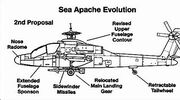
Sea Apache diagram